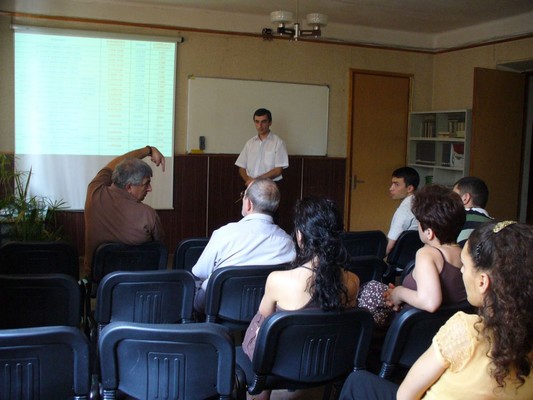The First Geomagnetic Storm of the 24th Solar Cycle Detected at Mt. Aragats
Joseph Dagdigian
June 11, 2010

Tigran Karapetyan discussing the data on the first geomagnetic storm of the 24-th solar cycle at the CRD seminar. Prof. Chilingarian enthusiastic about Tigran's report.
On April 5, 2010 at 5:55 AM Eastern Standard Time the Aragats Space Environment Center (ASEC) of Armenia.s Cosmic Ray Division (CRD) detected the first solar geomagnetic storm of the 24th solar cycle.
Solar cycles correspond to the periodic variation of the severity of the activity on the Sun as evidenced by sunspots. Sunspots are the temporarily cooled local regions on the surface of the sun due to a sudden super-energetic events, which release matter and very high amounts of energy from the sun. Most of the Solar cycles have a duration from 9 to 14 years. The counting of the cycles started in 1755, although, they have existed since the formation of the solar system. From 1645 to 1715 there was a prolonged period of minimum number of sunspots on the Sun.s surface, indicating low level of solar activity. During that same period, Europe experienced a "mini-ice-age", demonstrating the close relationship between solar activity and terrestrial effects.
CRD's ASEC cosmic ray detectors and other instrumentation at 6,500 ft and 10,500 ft elevation on Mt. Aragats detected a magnetic disturbance resulting from a solar Coronal Mass Ejection (CME) directed towards the earth. CMEs consist of huge amounts of magnetized solar material that is blasted from the surface of the Sun. This CME was directed towards the earth. Upon approaching the earth, it produced a disturbance of the earth's magnetic field, registering a Kp 7 on the scale of Kp 0 to Kp 9 for such events, where Kp 9 is the most severe disturbance. The CME was accompanied by a weak solar flare in which jets of charged particles were ejected from the sun's surface. Such magnetic disturbances, or Geomagnetic Storms, can wreak havoc with satellites in space, power distribution systems, pipelines, and other electrical systems on Earth. They are also dangerous for people in space and on over-the-pole flights.
"We are entering the active period of the 24-th solar cycle and we are ready to make many new measurements to support our space weather forecasting research. This new data will be combined with the data we gathered in the 23-rd cycle to help us characterize space weather. We also partner with cosmic ray research centers around the world to exchange, compare and correlate our data, since in our work, the entire globe is a detector", says Professor Ashot Chilingarian, the head of the Cosmic Ray Division.
Chilingarian was also appointed the director of the Yerevan Physics Institute in the Fall of 2009 in addition to his responsibilities at the Cosmic Ray Division of the institute. He continues on his unwavering mission to train a young generation of scientists and engineers for Armenia. Under his leadership Armenia has become one of the top 5 countries in cosmic ray research.
For more information about the work of the Cosmic Ray Division, please visit http://www.crdfriends.org .